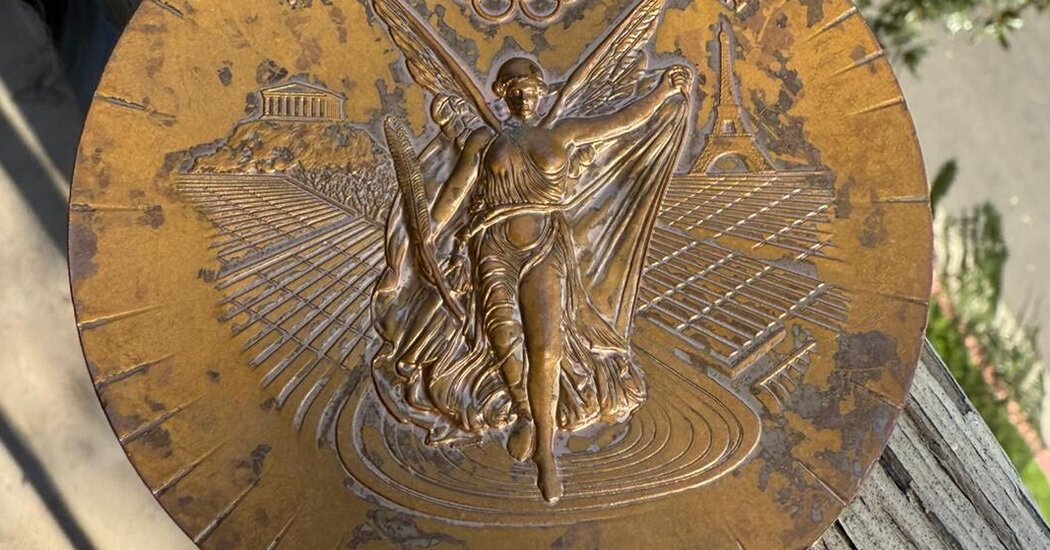Rarely in Olympic history has one company been as ubiquitous as LVMH Moët Hennessy Louis Vuitton, the luxury goods empire owned by France’s richest family.
As the largest corporate sponsor of the Olympic Games in Paris, LVMH was everywhere. Moët & Chandon champagne flowed in the VIP suites. French athletes were dressed by LVMH fashion house Berluti. And, contrary to at least the spirit of the Olympic charter, Louis Vuitton luggage was trotted out during the opening ceremony and seen by more than a billion people worldwide.
But its most important role was the Olympic medals, designed by Chaumet, a luxury jewelry and watchmaker and part of the LVMH group. Gold, silver and bronze: the very best athletes would take them home as a souvenir of their performance at the Paris Games.
Now those medals are falling apart – and LVMH is silent.
In just over 100 days since the Olympics closed, more than 100 athletes have asked for their crumbling medals to be replaced. Last month, French swimmers Clement Secchi and Yohann Ndoye-Brouard showed off their peeling medals on social media. “Crocodile skin,” Mr. Secchi wrote.
Nick Itkin, a U.S. Olympic foil fencer, said his bronze medal started to deteriorate a few days after the Olympics. “But after a few weeks it became clearer,” he said, adding that he planned to ask for a replacement.
Medals have had to be replaced at other Olympics – most notably Rio de Janeiro in 2016. But at no previous Olympics has a company stamped its brand credentials so prominently.
The problem appears to be most acute with the bronze medals, problems that athletes first began reporting shortly after receiving them.
The International Olympic Committee has apologized and said it will find replacements. Monnaie de Paris, the French mint that produced the medals, has so far taken responsibility, attributing the problem to a technical issue involving varnish.
And LVMH likes to let other organizations have their say. A company spokesperson said that because LVMH did not make the medals and is not responsible for them, it has no comment.
But in the run-up to the Games and during the event itself, LVMH showcased the role of its expert craftsmen in crafting the medals. On the second floor of a club it created, just a few meters from the Élysée Palace, the residence of the French president, designers from Chaumet proudly explained the years-long project to design the medals in secret. At the heart of each was a piece of the Eiffel Tower.
Chaumet had never designed a sports medal before, and of the three they had to create, the bronze was the most difficult.
“It’s the most difficult because it’s the most delicate,” Philippe Bergamini, one of Chaumet’s longest-serving jewelry designers, told The New York Times at the time.
The company adjusted the designs hundreds of times until a special committee of athletes and Olympic officials agreed. Designers then joined forces with the mint, a French institution that has been producing money and other precious objects since the Middle Ages.
Each medal took 15 days to complete, from punching out the design to dipping it in gold, bronze and silver and then finishing with a coat of varnish.
So when an athlete posted photos of his rusting bronze medal last August, just weeks after the Games, the mint began an internal investigation to “understand the circumstances and cause of the damage,” the organization said in a statement.
The mint discovered that the varnish used to prevent oxidation was defective. The varnish recipe is a trade secret, but the coating has been weakened after the mint modified it to comply with recent European Union regulations banning the use of chromium trioxide, a toxic chemical used to prevent metal from rusting, according to La Lettre, a French industry. newspaper.
A spokeswoman declined to confirm the report but said in a statement that the mint “has adjusted the varnish and optimized the manufacturing process to make it more resistant to certain uses observed by athletes of the medals.”
Faced with a flood of deteriorating medals, the International Olympic Committee has vowed to find replacements. “Damaged medals will be systematically replaced by the Mint of Paris and engraved in the same way as the originals,” the report said in a statement.
For LVMH, the Olympics were a coming-out party. It was a big step in the sport and a moment to promote the company in a way it had previously avoided, instead preferring to showcase its individual brands.
“Obviously because it’s about the medal, it’s a very high priority and everyone is asking how this can happen, especially since it comes from LVMH, whose raison d’etre is quality and precision,” said Michael Payne, who manages the devised the IOC’s original marketing strategy.





